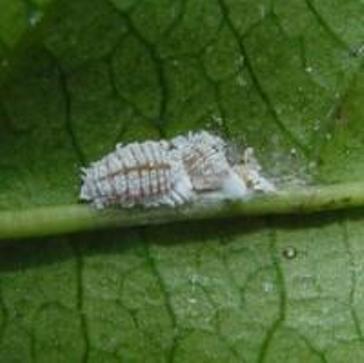
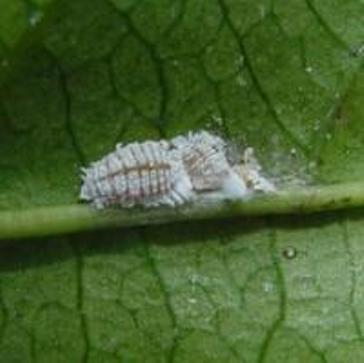
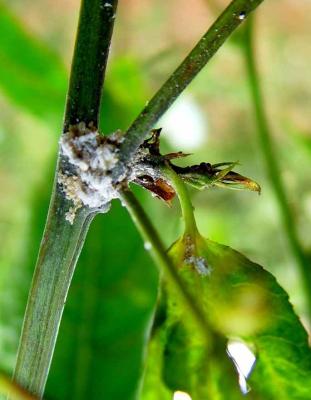
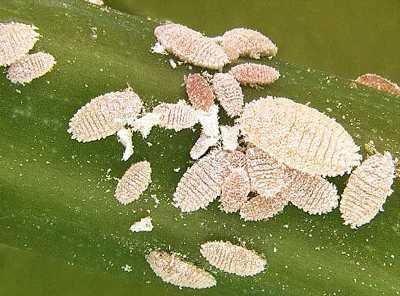
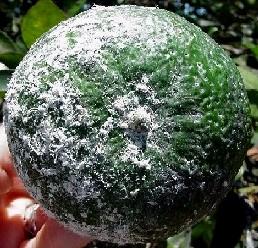
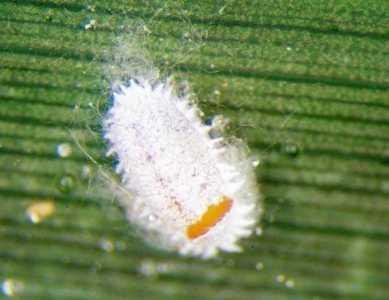
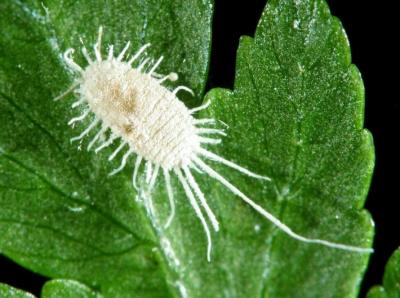
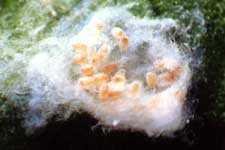
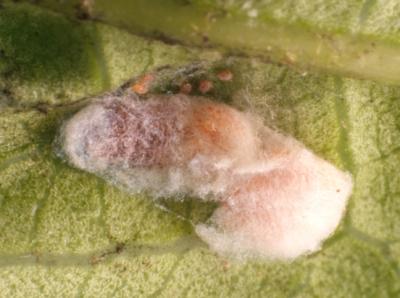
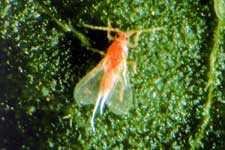
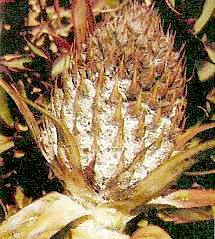
Notes for REVIEW
14.9.09 mh, Coconut, millet, papaya and yam were not marked as hosts, so for these hosts a pestmodule is missing, pls add. Kindly let me know which of the photos (under more images) to include inside the text, on the one hand we should include images for the biology ecology part, on the other we should include images of the different species. Biol./ecology: Expressions such as 'lateral and terminal filaments' pls exchange/or explain. I note a lot of species specific information from datasheet jan 08 has been deleted from this sheet (latest version from 25jul08) and not been transfered properly or only partly to the respective crops datasheets and or pestmodules. This has to be looked at thoroughly again. I have included all the lost texts under a specific section just below. Pls also look at pestmodule on coffee, whether we can summarize the two pestmodules for citrus and kenya mealybug in one, I have no possibilities to link two pestmodules to the same pest datasheet, so if different species of mealybugs are found on coffee, they should be described in a single pestmodule. We can include several photos and if the control methods differ we can separate the info.
Species-specific information (to be transferred to crop sheets and pestmodules)
Cassava mealybug
The cassava mealybug was accidentally introduced to Africa from South America. After the first reports in the 1970s, the insect became the major cassava pest within a few years and spread rapidly through most of the African cassava belt. The outbreak led to famine in several countries where cassava is a staple crop and particularly important in times of drought. The cassava mealybug causes severe damage by stunting the growing points of cassava plants, often totally defoliating the plants. Root yield losses of 84% have been reported. The pest-induced defoliation reduces availability of healthy leaves, which are consumed as leafy vegetables in most of West and Central Africa. After the pest cripples plant growth, weeds and erosion sometimes lead to total destruction of the crops. Additionally, pest-infested plants produce poor quality stem cuttings for use as planting material. The insect is more abundant and its damage severity is greater in the dry than in the wet season.
Symptoms: In cassava the pest causes stunting, leaf distortion, shortening of the internodes and loss, dieback and weakening of stems used for crop propagation.
Cultural practices: Use of manure or other fertilizers can result in a reduction in the mealybug population because improved nutrition results in the production of larger parasitoid wasps with higher fertility levels. Mulch and fertilizer use also enhances the antibiotic properties of cassava against mealybug infestation.
BIOPESTICIDES AND PHYSICAL MEASURES For cassava mealybug: Immersion of cassava cuttings in manipueira (a liquid extract from cassava roots) for 60 minutes was found to significantly reduce infestation. (where? How do you prepare the extract? Reference? Source of information?). (Move this to cassava datasheet). (People are unlikely to do this, since cassava mealybug is not longer a problem in most areas). Anyway pls include reference (mh, 14sept09).
Mango mealybugs
Rastrococcus iceryoides in East Africa and Rastrococcus invadens in West and Central Africa are major pests of mango. Severe attack can result in shedding of shedding of leaves and inflorescences, reduced fruit setting and shedding of young fruit. Fruits contaminated with honeydew and sooty mould have reduced market value and are unfit for export. The mealybugs cause direct damage to fruits leading to 40-80% loss depending on locality, variety and season.
Symptoms: Infestations start with the appearance of the first- and second-instar nymphs on the underside of the leaves on terminal shoots. As the population increases, they transfer to young shoots and inflorescences. Severely infested leaves turn yellow, gradually dry and ultimately defoliate. In cases of severe infestations, shedding of leaves or inflorescence, reduced fruit-setting and even shedding of young fruits can result. Honeydew and sooty mould soil leaves and fruits.
Cultural practices: Heavily infested branches may be pruned to control the pest, especially on the tender branches before flowering begins.
Citrus mealybug
Planococcus citri also known as the root mealybug is reported as a serious pest of coffee, citrus and cocoa. On coffee this mealybug is usually found attacking roots. As a result, the leaves wilt and turn yellow as if affected by drought. This mealybug is also found on the aerial parts of the coffee trees, but very rarely causes serious damage. On citrus, this mealybug attacks the above-the ground-plant parts. Feeding on citrus fruit affects fruit appearance, rendering them unacceptable for the fresh fruit market. This mealybug is a vector of many cocoa viruses and is the second most important vector of the Cocoa Swollen Shoot disease in West Africa.
Symptoms: Feeding of citrus mealybugs leads to general wilting of the plants due to sap depletion. Infestation by citrus mealybugs also causes indirect physical damage because of the sooty moulds that develop on the honeydew secreted by the mealybug.
On coffee this mealybug is usually found on the roots; attacked roots are often stunted and encased in a thick case of greenish-white fungal tissue. As a result the leaves wilt and turn yellow as if affected by drought. This mealybug is also found on the aerial parts of the coffee trees, but very rarely causes serious damage. On citrus, this mealybug is found attacking the above-the ground-plant parts. Feeding on citrus fruit results in discoloured, bumpy, and scarred fruit, with low market value, or unacceptable for the fresh fruit market.
Natural enemies for the citrus mealybug that have been successfully used include Leptomastix dactylopii, a parasitoid of South American origin, and the predators Cryptolaemus montrouzieri, Exochomus flavipes and Anagyrus pseudococci.
Cultural practices: In the highlands of Java, the shade tree Leucaena glauca is main food plant of citrus mealybug at altitudes above 600m (2000 ft.). Measures that proved successful for the control of citrus mealybug were mainly directed against infestation of this tree and consisted of removing the flower clusters or, when necessary, pruning all foliage and flowers. It is also claimed that citrus mealybug can be controlled by increasing the shade in plantations and that this was undesirable for Robusta coffee but suitable for Arabica at high altitudes. Good results were obtained by providing three covers, one above the other, of Leucaena, Erythrina and Albizia, or with Leucaena and Albizia only. It is further suggested that because the insect infests mainly the flowers and pods of L. glauca, other shade trees that seldom flower, such as L. pulverulenta (L. leucocephala), or a sterile hybrid of L. glauca and L. glabrosa should be planted. MOVE TO DATASHEET ON COFFEE.
Pineapple mealybug
Dysmicoccus brevipes is major pest of pineapple as it is a vector of the Pineapple Wilt Virus. They live singly or in groups in leaf axils, roots and around the collar. Most mealybugs live in colonies underground with only a small portion living on the leaves. Pineapple mealybugs are often carried from affected to healthy plants by ants and this greatly contributes to the spread of the pest and the virus.
Symptoms: Heavy infestations are conspicuous because of the white waxy adults, which often occur at the growing points, around the stem nodes, on the undersides of leaves, on the fruit and on the roots. Feeding on leaves causes yellowing and drying up of the leaf-tips which progresses towards the base of the leaves. On roots the sucking activity is associated with the rotting of roots and subsequent wilting of the plant.
Pink sugarcane mealybug
Saccharicoccus sacchari is considered to be a major pest of sugarcane mainly because the mealybug feeding and the honeydew secretion may lead to a reduction of the sugar yield and quality.
Symptoms: Mealybugs aggregate around the nodes of cane underneath the leafsheaths. Heavily attacked plants have thin stunted canes and are covered with honeydew and sooty mould.
Long-tailed mealybug
Symptoms: Heavy infestations of long-tailed mealybugs appear as white, waxy masses of mealybugs on stems, fruits and along the veins on the underside of leaves. Heavy infestations usually result in fouling of adjacent stems and leaves with honeydew and sooty mould.
Natural enemies: The long-tailed mealybug is maintained under good biological control in Californian citrus and avocado orchards by the hymenopteran parasitoids Tetracnemoidea sydneyensis and T. peregrina, assisted by predation by the coccinellid Cryptolaemus montrouzieri. Infestations of long-tailed mealybugs are attended by ants, which collect the honeydew.Ants play an important role in deterring the natural enemies of long-tailed mealybugs.
Phenacoccus ssp., Planococcus spp., Pseudococcus spp., Rastrococcus spp., Ferrisia virgata, Dysmicoccus brevipes, Saccharicoccus sacchari
